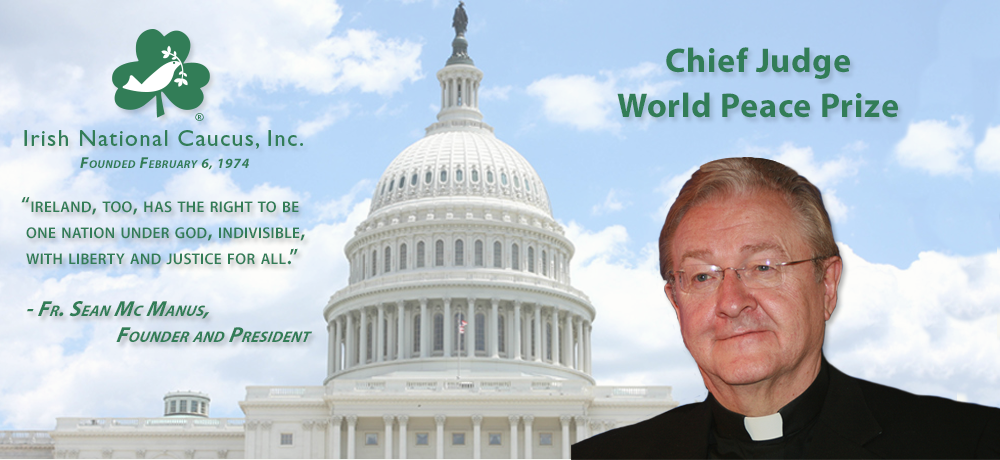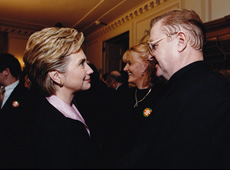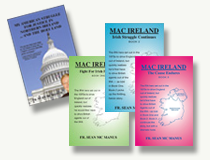Reiss Can Still Do The Job, And Well
Posted By: March 29, 2013
By Ray O’Hanlon
Irish Echo. October 12 – 16, 2005
In early August, with the North summer marching headlong into yet more
bitter street confrontations, Irish American leaders gathered in New
York with Hillary Rodham Clinton to discuss U.S. policy towards
Northern Ireland and how Irish America could inject some new life into
the peace process.
One of the ideas floated at the meeting was to focus on a possible
successor to Ambassador Mitchell Reiss as U.S.
special envoy to ! the wee North.
True, Reiss had been off the radar a bit as he settled back into the
groves of academe at William and Mary College in Virginia.
It is here that Reiss lectures and ponders what can be done with what
is his number one northern pursuit: that of analyzing the murky
political machinations of North Korea, or as it likes to call itself,
the Democratic People’s Republic of Korea.
But Reiss hadn’t completely forgotten that other North and word was
that he was not a happy camper when he learned that some folk in
faraway New York were already looking beyond his tenure as envoy.
True, William and Mary is as good place as any to contemplate a
conundrum such as Kim Jong Il’s earthly paradise.
And it would equally serve as a good place to put on the back burner
and forget about the perennial headscratcher that is Norn’ Ireland.
The campus, located in Colonial Williamsburg, looks like a period
painti! ng and the college’s academic reputation is as solid as they
come.
Until recently, the chancellor was Henry Kissinger and he has been
replaced by retiring Supreme Court justice Sandra Day O’Connor.
The college itself goes back to 1693 when it received it’s charter from
none other than King William of Orange and his missus, Queen Mary 11.
Given such august founders, Reiss’s sense of irony must have been given
a jolt when King Billy’s latter day followers went bananas on the
Whiterock Road.
As it turned out, Reiss wasn’t walking the gilded halls of William and
Mary when September began to resemble the Julys of yore. He was
actually in the auld sod.
Always the diplomat, Reiss didn’t entirely loose the rag when the
September loyalist riots turned parts of Belfast into a war zone. But
he did accuse unionist leaders of dropping the ball big time.
Leadership was needed, Reiss said, but not much had been in e! vidence
during the several days of disturbances following a Parades Commission
decision to divert an Orange march down a street a few yards from the
Order’s intended, “traditional,” route.
Reiss said that there had been “absolutely no excuse” for the trouble.
“What you really need is leadership, and unfortunately in the last few
days, we haven’t seen very much of it,” he said.
“I think all of us are pretty disappointed with the abdication of
responsibility by many unionist political leaders.”
Needless to say, these comments didn’t go down too well with unionists
and it wasn’t long before Reiss was at the wrong end of a verbal tongue
lashing from Ian Paisley’s DUP.
The party’s Nigel Dodds accused Washington’s ambassador of making one
of the most unhelpful, negative and damaging contributions he had ever
heard.
Dodd’s described Reiss’s criticism of unionist leadership failings as
“crass” and said that! the U.S. envoy no longer had any credibility
among unionists.
At this juncture, the meanderings of Kim Jong Il — dear leader, or
whatever his people are required to call the guy
— must have been taking on a whole new appeal.
Having no credibility with unionist leaders would ordinarily be a bit
of a handicap for anyone trying to get a handle on the North imbroglio.
But it certainly did Reiss’s flagging profile no harm with Irish
America.
The man was back in the frame, front and center.
He was again in more recent days when he briefed Irish American
community leaders at the State Department.
Irish National Caucus president Fr. Sean McManus came away from the
event in no doubt that the U.S. role in the peace process was still in
very good hands.
“He is very impressive,” McManus said of Reiss.
“I would have the greatest confidence in Ambassador Reiss,”
McManus added.
“While I might disagree wi! th him on individual, specific issues, I
think he can still do an excellent job and will.”
For as long as his president wants him to that is. But will that mean
the entirety of President Bush’s second term?
That could in large part depend on Reiss and his own judgment as to how
much time he can set aside for a peace process that still seems intent
on taking a step back every time it takes one forward.
If he decides to step down from the envoy post, or if he is replaced,
will the new envoy be, like Reiss and Richard Haass before him, a State
Department diplomat?
Or will the administration plump for someone from an entirely
different, perhaps non-diplomatic background?
The New York meeting of early August seemed to thinking in precisely
these terms.
It actually came up with a list of potential envoys. It’s called the
“Initial Potential Name List for Irish Special Envoy Presidential
Appointment.”
Quite a mouthful.
Here — drum roll please — is the list: Ambassador Howard Baker,
Tom Brokaw, Mario Cuomo, Bob Dole, Bill Flynn, Lee Iacocca, former
Oklahoma Governor Frank Keating, former senator Sam Nunn, George
Pataki, Colin Powell;
General Norman Schwarzkopf, and former General Electric head Jack
Welch.
It’s an intriguing list to be sure. And there are few in Irish America
who wouldn’t relish the prospect of Stormin’
Norman taking on Nigel Dodds, Big Ian et al.
But frankly, the list looks a little unlikely for any number of
reasons. At the same time it’s never too early to look ahead.
Irish America will continue to make Northern Ireland an election issue
as best it can and the identity of who occupies the special envoy job
is intricately tied in with such an effort.
In the meantime, however, the envoy is Mitchell Reiss. And he appears
to be more than up to the job.
This story appeared ! in the issue of October 12 – 16, 2005










